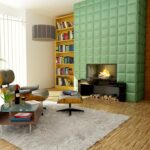Did you know that 50% of adults sleep in a queen size bed?
Are you wondering what interior design principles you can follow for your bedroom? Interior design is about creating the perfect environment to be yourself at home. But figuring out what you want to do can be tricky.
Read below to learn the best interior design for bedrooms.
1. Contrast
Contrast is one of the classic interior design principles for bedrooms. Contrast focuses on juxtaposing complementary opposites in your design, such as light and dark, hard and soft, or cool and warm tones.
The contrast in color can be used to create a visually stimulating room. Bold blues on accent walls will bring an air of coolness, while warmer, neutral tones create a cozy atmosphere. Different textures in linens can also be used to contrast and create visual interest.
2. Emphasis
When creating beautiful interiors, emphasis is critical. The emphasis provides a focal point for the room and dictates the overall feel of the space.
Creating emphasis includes placing a dominant piece of furniture centrally in the room or painting an entire wall a contrasting color from the other walls. Power is also achieved through contrasting textures, materials, and lighting.
3. Harmony
Harmony is achieved through patterns and textures that blend in a pleasing and calming way. Textures, such as adding texture to a wall or floor, can add a layered effect while adding a cozy and warm feeling to the space.
Harmonizing these elements together will create a tranquil and inviting space anyone can positively escape. So if you want to get the best items to match your chosen interior bedroom design, be sure to visit Somn.
4. Scale
It involves strategically arranging furniture and decor about the size of the room to maximize available space and avoid overcrowding. An effective bedroom design should use the correct size pieces for space and remember to keep elements proportional.
For instance, a small bedroom with a King-sized bed creates an issue of scale. On the other hand, if a roomy bedroom had a Twin-sized bed, it would look dreary and empty.
5. Rhythm
The interior design principle of rhythm is essential in creating a comfortable, inviting bedroom. By adding repetition and structure, rhythm emphasizes the elements that unite rather than the ones that divide.
Accessories such as pillows, throws, rugs, and artwork that share a similar color palette can all add to a space’s cohesion. Adding eye-catching focal points, such as a large piece of furniture or artwork hung over a bed, can also create rhythm in a room.
6. Unity
Unity is an essential principle in interior design, and it can be applied to a bedroom setting exceptionally well. When decorating, let the more oversized items, such as the bed, be the focal point and maintain the same style when incorporating other pieces, such as end tables and dressers. This can create unity in the room and give it a complete look.
A few accent pieces, such as throw pillows or a rug, that also adhere to the color palette can be a great way to tie together the design.
Adding Interior Design Principles In Bedrooms
Designing your bedroom doesn’t have to be intimidating when armed with these interior design principles. From the use of wall coverings to the placement of furniture, use them to create a livable, beautiful space.
Transform your bedroom into a calming, comfortable retreat that can be enjoyed for years.
If you want to learn more, read more articles on our website.




